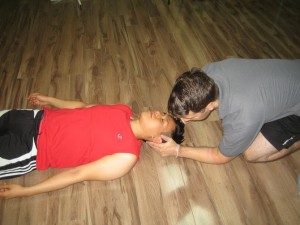Neurogenic occurs when there is damage to the central nervous, which is composed of the brain and the spinal cord, resulting to damage in the nerves of the autonomic nervous system (elsewhere in the body). It is considered to be a type of distributive shock, a type of shock that is caused by the poor distribution of blood to the tissues of the body. Despite normal myocardial function and normal intravascular volume, the irregularity in blood flow can result to poor tissue oxygenation, especially in the extremities.
The danger of neurogenic shock is that it affects the nerves that influence heart rate and other involuntary functions of the body. Injury to the nerves results to the relaxation of the blood vessel walls, which then leads to hypotension (low blood pressure) and sometimes, bradycardia (decreased heart rate). Consequentially, the heart’s ability to pump also diminishes. Furthermore, there is decreased systematic vascular resistance (the resistance that blood must overcome to flow through the blood vessels).
Neurogenic shock is considered a medical emergency that requires immediate medical attention. It is different from spinal shock, which refers to loss of function due to a spinal injury.
Causes of Neurogenic Shock
There are several causes of neurogenic shock, which include:
- Trauma or injury to the brain or spinal cord, especially those leading to the rotation, dislocation or over-extension/ flexion of the latter
- Penetrating injuries, such as stab wounds, gunshot wounds, etc.
- Blunt injuries, such as car accidents, sport injuries, falls, etc.
- Medication drugs that influence the autonomic nervous system
- Regional anesthesia that is improperly administered
Signs and Symptoms of Neurogenic Shock
Like all cases of shock, neurogenic shock is a medical emergency. However, the sign that makes neurogenic shock distinct from other types of shock is the presence of warm limbs with the rest of the body cold to touch whereas other types of shock are characterized by cool, clammy skin. The other signs and symptoms of neurogenic shock include:
- Hypotension or low blood pressure (primary sign)
- Bradycardia (decreased heart rate)
- Weak pulse
- Rapid, shallow breathing
- Feeling cold
- Excessive sweating
- Little or no urine output
- Confusion and anxiety
- Dizziness
- Staring blankly
- Loss of consciousness
First Aid Management for Neurogenic Shock
Once an individual begins to show signs and symptoms of neurogenic shock, call for emergency medical services as soon as possible. Administer first aid while waiting for medical help to arrive. The following steps are recommended in cases of neurogenic shock:

- Immobilize the spine to prevent any further damage on the victim. Move the victim only if it is absolutely necessary, e.g. danger in the immediate surroundings.
- If vomiting or drooling is present, hold the victim’s head, neck and back in a line, similar to a log, and roll the victim to the side as a unit.
- Check the casualty’s circulation, airway and breathing. Initiate rescue breathing and CPR if necessary.
- Check and monitor the casualty’s rate of breathing every 5 minutes even if the individual can breathe on their own.
- If there are injuries, such as bleeding or broken bones, apply appropriate first aid.
- Loosen any tight clothing.
Neurogenic shock occurs when there is damage to the central nervous system thus leading to damage in the nerves of the autonomic nervous system.
